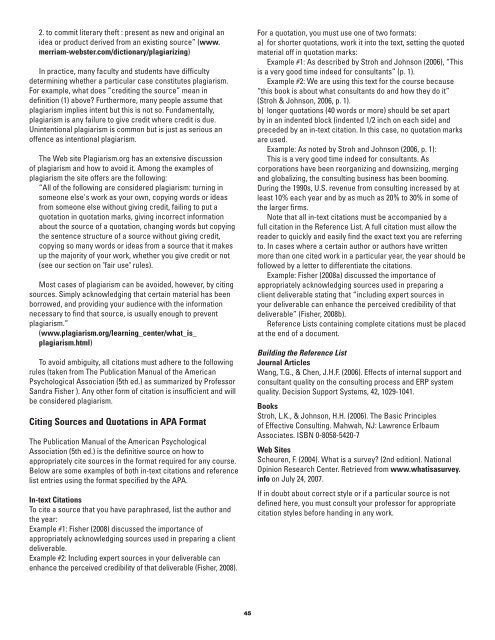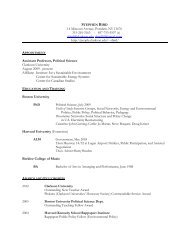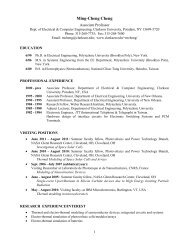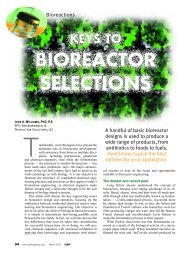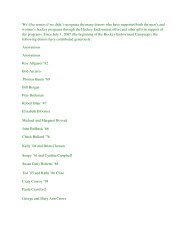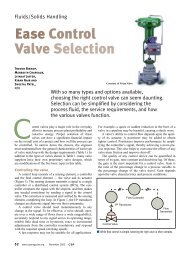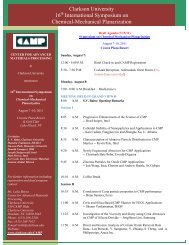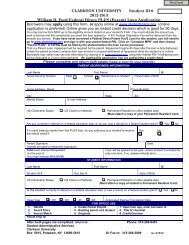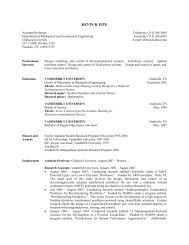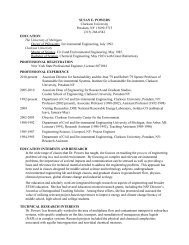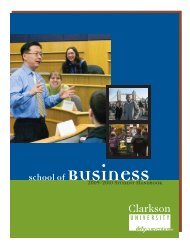School of Business - Clarkson University
School of Business - Clarkson University
School of Business - Clarkson University
You also want an ePaper? Increase the reach of your titles
YUMPU automatically turns print PDFs into web optimized ePapers that Google loves.
2. to commit literary theft : present as new and original an<br />
idea or product derived from an existing source” (www.<br />
merriam-webster.com/dictionary/plagiarizing)<br />
In practice, many faculty and students have difficulty<br />
determining whether a particular case constitutes plagiarism.<br />
For example, what does “crediting the source” mean in<br />
definition (1) above? Furthermore, many people assume that<br />
plagiarism implies intent but this is not so. Fundamentally,<br />
plagiarism is any failure to give credit where credit is due.<br />
Unintentional plagiarism is common but is just as serious an<br />
<strong>of</strong>fence as intentional plagiarism.<br />
The Web site Plagiarism.org has an extensive discussion<br />
<strong>of</strong> plagiarism and how to avoid it. Among the examples <strong>of</strong><br />
plagiarism the site <strong>of</strong>fers are the following:<br />
“All <strong>of</strong> the following are considered plagiarism: turning in<br />
someone else's work as your own, copying words or ideas<br />
from someone else without giving credit, failing to put a<br />
quotation in quotation marks, giving incorrect information<br />
about the source <strong>of</strong> a quotation, changing words but copying<br />
the sentence structure <strong>of</strong> a source without giving credit,<br />
copying so many words or ideas from a source that it makes<br />
up the majority <strong>of</strong> your work, whether you give credit or not<br />
(see our section on "fair use" rules).<br />
Most cases <strong>of</strong> plagiarism can be avoided, however, by citing<br />
sources. Simply acknowledging that certain material has been<br />
borrowed, and providing your audience with the information<br />
necessary to find that source, is usually enough to prevent<br />
plagiarism.”<br />
(www.plagiarism.org/learning_center/what_is_<br />
plagiarism.html)<br />
To avoid ambiguity, all citations must adhere to the following<br />
rules (taken from The Publication Manual <strong>of</strong> the American<br />
Psychological Association (5th ed.) as summarized by Pr<strong>of</strong>essor<br />
Sandra Fisher ). Any other form <strong>of</strong> citation is insufficient and will<br />
be considered plagiarism.<br />
Citing Sources and Quotations in APA Format<br />
The Publication Manual <strong>of</strong> the American Psychological<br />
Association (5th ed.) is the definitive source on how to<br />
appropriately cite sources in the format required for any course.<br />
Below are some examples <strong>of</strong> both in-text citations and reference<br />
list entries using the format specified by the APA.<br />
In-text Citations<br />
To cite a source that you have paraphrased, list the author and<br />
the year:<br />
Example #1: Fisher (2008) discussed the importance <strong>of</strong><br />
appropriately acknowledging sources used in preparing a client<br />
deliverable.<br />
Example #2: Including expert sources in your deliverable can<br />
enhance the perceived credibility <strong>of</strong> that deliverable (Fisher, 2008).<br />
45<br />
For a quotation, you must use one <strong>of</strong> two formats:<br />
a) for shorter quotations, work it into the text, setting the quoted<br />
material <strong>of</strong>f in quotation marks:<br />
Example #1: As described by Stroh and Johnson (2006), “This<br />
is a very good time indeed for consultants” (p. 1).<br />
Example #2: We are using this text for the course because<br />
“this book is about what consultants do and how they do it”<br />
(Stroh & Johnson, 2006, p. 1).<br />
b) longer quotations (40 words or more) should be set apart<br />
by in an indented block (indented 1/2 inch on each side) and<br />
preceded by an in-text citation. In this case, no quotation marks<br />
are used.<br />
Example: As noted by Stroh and Johnson (2006, p. 1):<br />
This is a very good time indeed for consultants. As<br />
corporations have been reorganizing and downsizing, merging<br />
and globalizing, the consulting business has been booming.<br />
During the 1990s, U.S. revenue from consulting increased by at<br />
least 10% each year and by as much as 20% to 30% in some <strong>of</strong><br />
the larger firms.<br />
Note that all in-text citations must be accompanied by a<br />
full citation in the Reference List. A full citation must allow the<br />
reader to quickly and easily find the exact text you are referring<br />
to. In cases where a certain author or authors have written<br />
more than one cited work in a particular year, the year should be<br />
followed by a letter to differentiate the citations.<br />
Example: Fisher (2008a) discussed the importance <strong>of</strong><br />
appropriately acknowledging sources used in preparing a<br />
client deliverable stating that “including expert sources in<br />
your deliverable can enhance the perceived credibility <strong>of</strong> that<br />
deliverable” (Fisher, 2008b).<br />
Reference Lists containing complete citations must be placed<br />
at the end <strong>of</strong> a document.<br />
Building the Reference List<br />
Journal Articles<br />
Wang, T.G., & Chen, J.H.F. (2006). Effects <strong>of</strong> internal support and<br />
consultant quality on the consulting process and ERP system<br />
quality. Decision Support Systems, 42, 1029-1041.<br />
Books<br />
Stroh, L.K., & Johnson, H.H. (2006). The Basic Principles<br />
<strong>of</strong> Effective Consulting. Mahwah, NJ: Lawrence Erlbaum<br />
Associates. ISBN 0-8058-5420-7<br />
Web Sites<br />
Scheuren, F. (2004). What is a survey? (2nd edition). National<br />
Opinion Research Center. Retrieved from www.whatisasurvey.<br />
info on July 24, 2007.<br />
If in doubt about correct style or if a particular source is not<br />
defined here, you must consult your pr<strong>of</strong>essor for appropriate<br />
citation styles before handing in any work.


